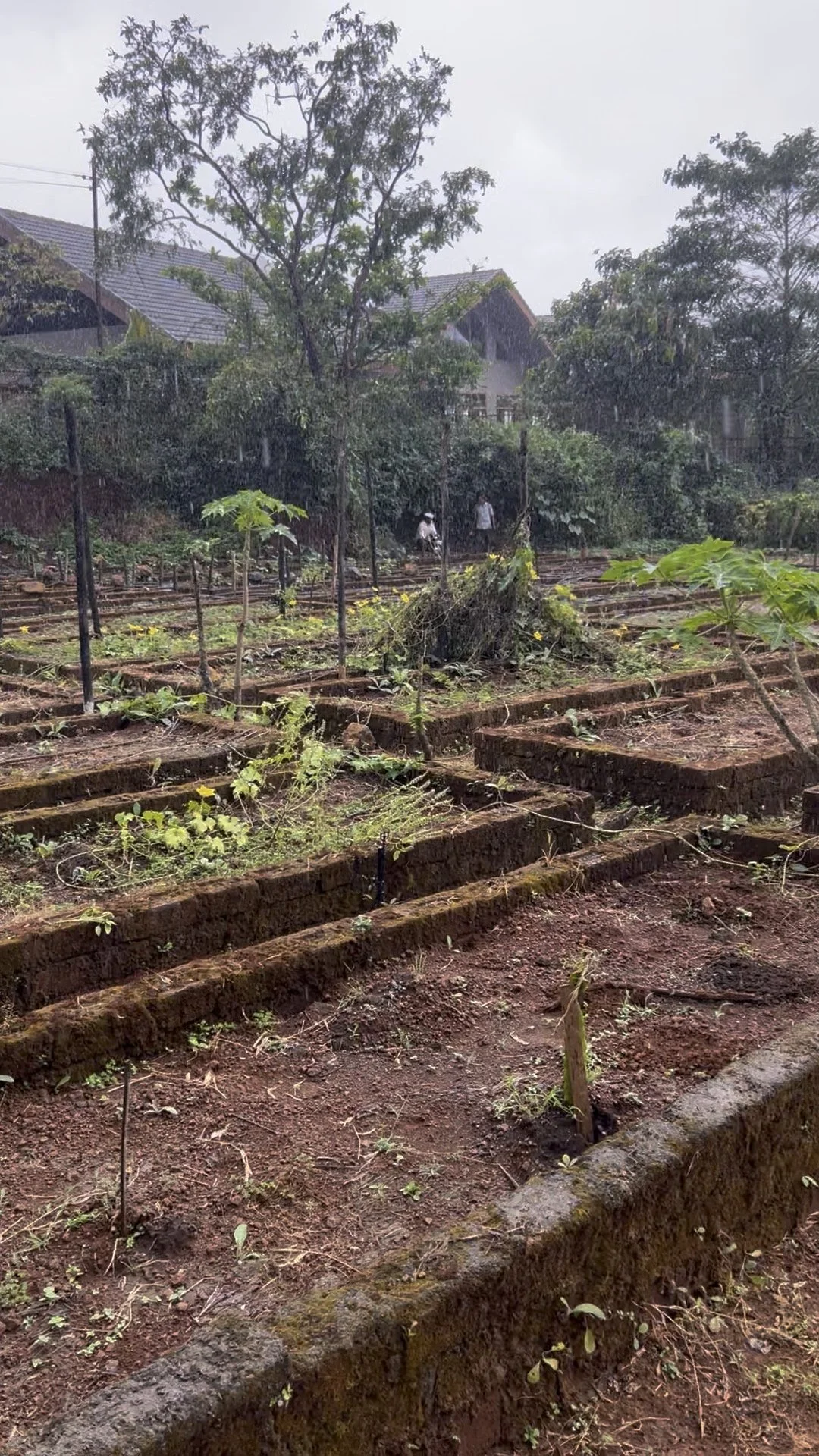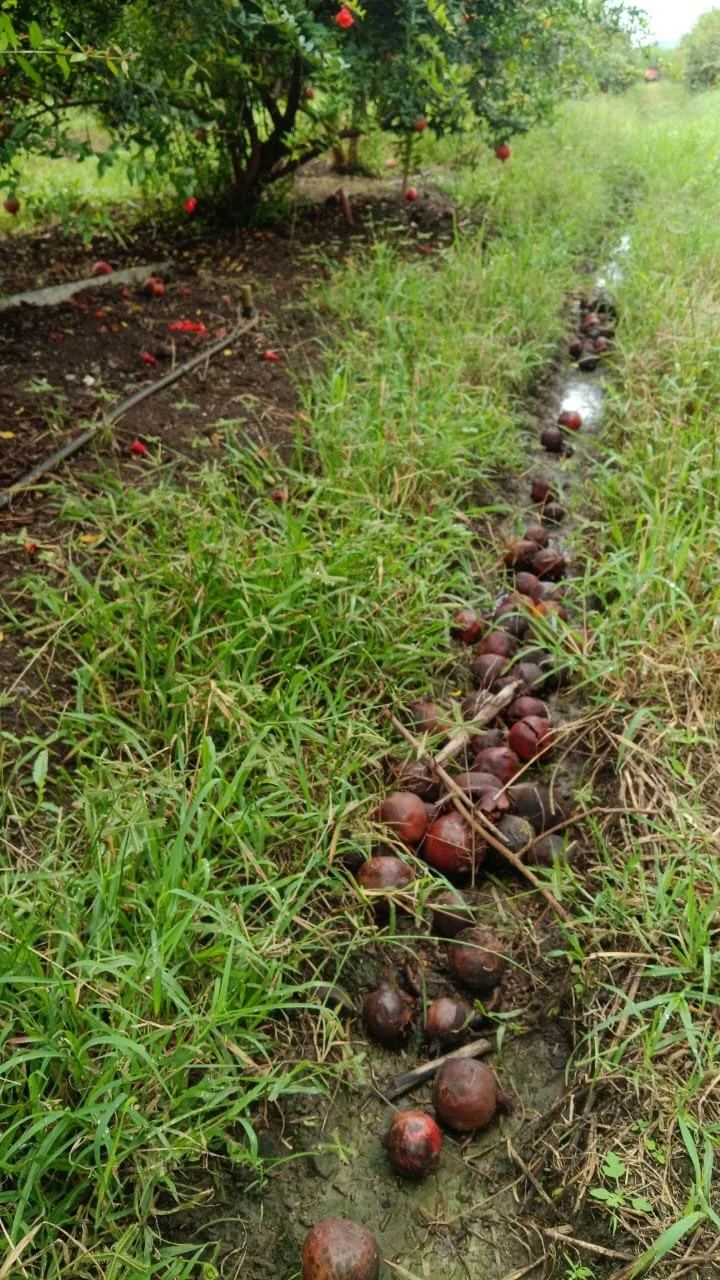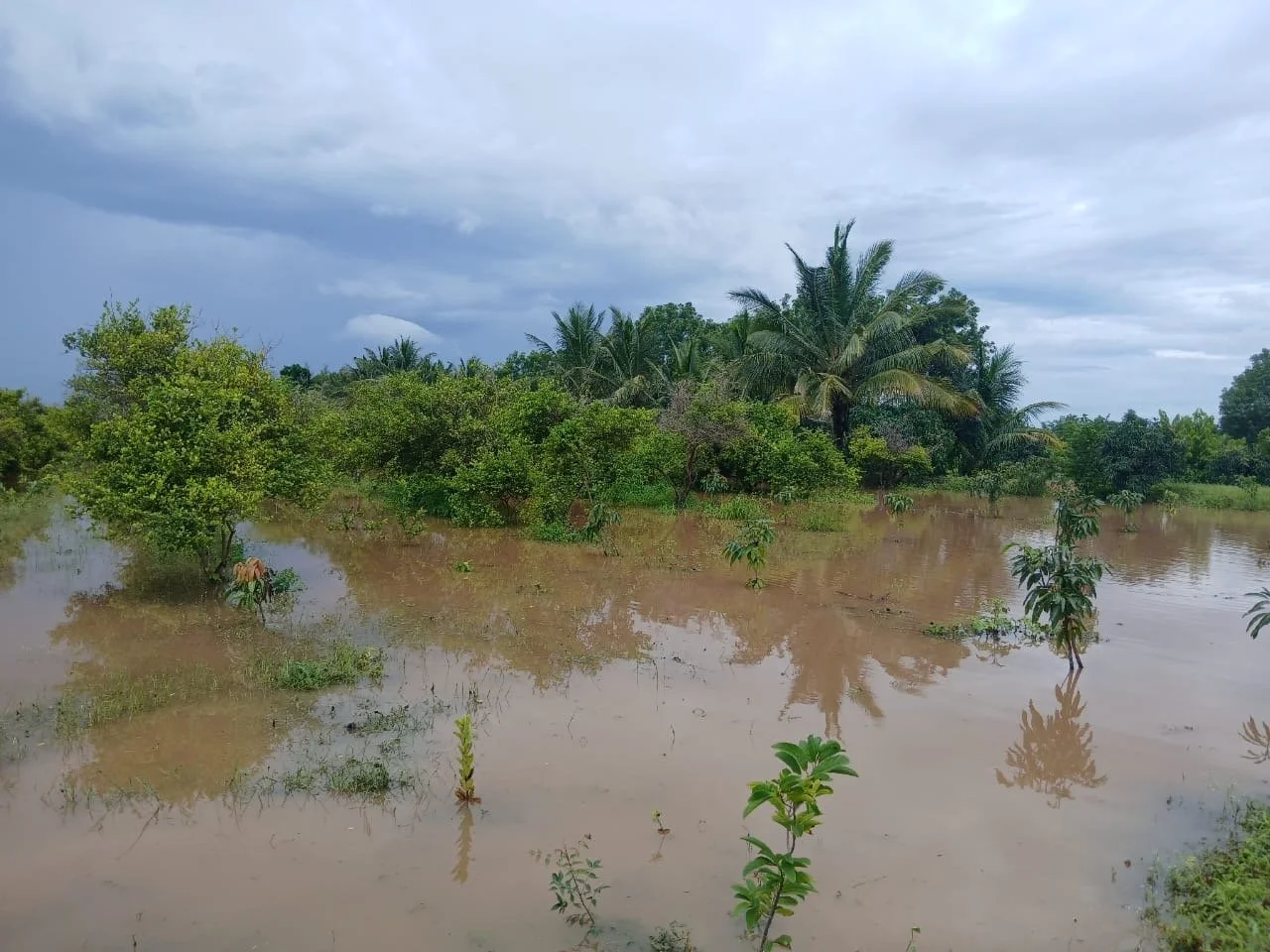The Monsoon That Wouldn't End

In the wake of unceasing, unseasonal rains, Simran Moorjani speaks to other farmers to understand how this prolonged season of rain has affected them.
It is the beginning of November. I've come to the farm with about 70 tomato saplings ready to be transplanted into the beds I’ve prepped for them. But it is pouring down on me; it has been this way since the middle of May. I’ve been farming tomatoes and winter vegetables for the last two winters on a piece of land near Lonavala. I had planned on starting my third season. But today is not the day, I think defeatedly.
The author...
And her farm.
The beds cannot drain the water that is collecting in them, and would drown anything I planted — that much I knew. But a delay in planting means a delay in the plant’s life cycle — in growth, fruiting, flowering, and eventually, in harvest and sale. Over the years, I’ve built a small but cherished clientele who expect my produce as soon as winter arrives. By November, we’re usually done with our first round of planting on the farm. This year, I haven't yet begun.
While I do hope the farm will one day be my primary source of income, days like these remind me I’m not ready; maybe I never will be. I split my time between a job in Mumbai, and a personal pursuit of a life in agriculture on a family plot outside the city. I like to call myself a farmer, though I’m not sure I’ve earned the title yet. My main income doesn’t depend on the land or rain. Still, I feel deeply disheartened and frustrated to realise that despite my tools and plans, my off-season schemes and dreams, it is all rather pointless without the weather’s cooperation. It makes me think of those who spend their entire lives on the land, watching its patterns shift and witnessing firsthand how climate change has reshaped their livelihoods. Farmers far wiser and more experienced than I am, that have shaped this article. Farmers I am lucky to call friends.
To understand how this prolonged season of rain has affected farmers across the subcontinent, I spoke with growers from different regions and disciplines. Mr. Ajoy Thipaiah of Kerehaklu, a chemical-free coffee estate in Chikmagalur is President of the United Planters' Association of Southern India (UPASI), and a fourth generation farmer. His insights extended beyond coffee to tea, rubber, pepper, and more. He explained that just as there is ‘Heat Stress,’ there is also ‘Water Stress.’ When it rains so hard over a prolonged period of time, the soil becomes saturated. This year’s rainfall far exceeded the soil’s absorption and draining capacity. As water stagnates at the feet of the soil, it puts the plant into a state of stress. “You see, the plants are already doing a lot of work – photosynthesis, converting sunlight to energy, nutrient exchange at the roots, sending those nutrients up and down, communicating with other plants through intricate fungal networks through their roots, trying to fight any pathogens that may affect it – it’s a full plate! Now when affected with Wet Feet (a condition where stagnant water remains at the base of the plant for a prolonged period), the plant goes into a state of stress and stops its daily functions to first work on survival.”
Much like our bodies under stress, when adrenaline triggers the fight-or-flight response — speeding up the heartrate, diverting blood to muscles, and shutting down non-essential systems like digestion, immunity, and growth — plants too face a survival dilemma. When under stress, they must decide whether to redirect resources to stay alive by dropping their fruits, or to prioritise reproduction by shedding leaves so their kin may survive. If water stress persists, however, survival isn’t even an option; the plant will inevitably die.
A whole row of Coffee Arabica plants, that have dealt with this excessive monsoon by choosing to shed all leaves, and try to focus on reproduction instead, with all the unripe fruits still attached on its branches.
When under stress, plants must decide whether to redirect resources to stay alive by dropping their fruits, or to prioritise reproduction by shedding leaves. If water stress persists; the plant will inevitably die.
A ruined pomegranate crop.
Rice farmers from Sindhudurg, in the southern part of the Konkan region of Maharashtra, have been in a race against time with the rain this year. “Most rice varieties in the region mature between mid-September and mid-October — a delicate window that depends on the monsoon’s timing and consistency. When the rains linger longer than expected or arrive with unusual intensity, like they have this year, fields can remain waterlogged just as the crop is ready for harvest” says Ashwin Paranjpe. Ashwin manages a 10-acre arabica and spice farm in Mulshi, Maharashtra, and a 5-acre farm in Anav, Sindhudurg, where he grows native rice varieties, coconuts, black pepper, and vanilla. He was fortunate enough to get a 4-5 day window to harvest, thresh, and bag all his rice, and that is largely attributed to the fact that he isn’t growing very large quantities of rice to begin with. “Farmer’s who grow rice over more land are having their entire crop snatched away by the rain, after putting in many months of work into it.”
It isn’t just an extended monsoon, but the entire monsoon calendar being turned on its head that has been particularly painful this year. Fiona Arakal and her husband Srikant Suryanarayan run India’s largest caper farm, practicing natural open-field cultivation and creating caper-forward condiments to add value at source. Fiona explains how the East Coast, fed by the North-East Monsoon, shapes the natural cycle of caper production. Their planting, pruning, and harvesting schedule is designed to work in tandem with this. The heavy rains arrive from November to mid-January, just after the long harvest season, when the caper plants naturally enter dormancy to rest and rejuvenate. After Pongal, as temperatures rise, the plants come back to life and begin producing new shoots and flower buds — a stage called Bud Break. From March onwards, they harvest the immature buds we know as capers, for a period of eight months, until October.
“This year, however, the rains came early. March through May stayed unusually cloudy, delaying bud growth and pushing the start of harvest to June. We managed to harvest through June, July, August, and September before the rains returned prematurely in October, washing out the fields once again.” Fiona described walking knee-deep in soft black cotton soil, pruning the plants whenever they found momentary respite from the rain.
What is usually an eight-month harvest was cut down to four — half the time, half the yield. The toll on both the land and the livelihood it sustains, is immense.
Similarly, where coffee goes, timing is everything. “After an intense harvest season, we begin shade regulation in early summer. Tree climbers lightly trim excess side branches from the larger shade trees,” explains Mr. Ajoy Thipaiah. “This allows more sunlight to reach the coffee plants, and triggers the plant’s instinct to reproduce.”
This leads to efflorescence, or flowering, which in turn determines the quality of the year’s crop. “Flowering only occurs when the plant feels the full brunt of summer,” Ajoy adds. “If the rains arrive too early, the plant relaxes - it enjoys the moisture, focuses on vegetative growth, and forgets to flower.”
And Kiran Kotulkar, a biodynamic farmer in Mawal, Maharashtra, who has been guiding me on recipes and formulas for natural inputs in my own farming journey, explains the biodynamic calendar, acknowledging that while forecasters did predict heavier than usual rainfall this year, no one expected it to be this extreme. “Usually, once the rice harvest is done, we shift all our focus to the winter vegetable crop,” he explained. “But with the rains still around, we haven’t been able to plant anything. We’ve been paying our workers for two months without any actual work.”
He added that customers and families they’ve supplied for nearly a decade are already asking for their usual winter vegetables. “In our absence, they’ll likely turn to others who don’t grow with the same ethics or care,” he said. It’s like running an account that’s all expenses and no income — quietly draining the owner dry.
Kiran Kotulkar’s citrus plot
If an extended monsoon in Mumbai means we can’t escape mould creeping onto our walls and clothes, can you imagine what weeks of constant moisture can do to open farmland? Wind spreads fungal spores and wet leaves are the perfect magnet for them; a moist atmosphere is the perfect environment for them to thrive. Entire plantations turn into breeding grounds for diseases – Leaf Rust & Black Rot in Coffee plants, Blight in Tomatoes & Potatoes, and Phytophthora Wilt in pepper vines. What should be a brief season of rejuvenation slowly starts to resemble a slow rot – silent, spreading, and hard to reverse once it sets in. Nature’s once predictable rhythm is now an erratic cacophony, leaving the people responsible for the food we eat, at high risk.
Leaf rust in coffee.
Blight in tomatoes.
City life is a tough one, no doubt. But it is also a life of dominance, of throwing money at problems, and making darn sure you get your time and money’s worth – be it at the work place or at a restaurant you’ve come to dine at. It runs on efficiency, deadlines, and guarantees. It’s also a life lived mostly indoors; work is not affected by the weather as much as it is by the WiFi.
The farmers I’ve spoken to are primarily natural farmers, trying their hardest not to dominate land, but to be stewards of it. They are in conversation with the land. There are days when nothing can be done because the rains won’t stop, and seasons when pests take over despite every precaution. Life, as dramatic as it may sound, is truly at the mercy of the weather gods.
Farmers are a community adept at thinking on their feet, of pivoting when needed, of doing the best with what they have. Just as we diversify our investment portfolio, farmers have long realized that the way forward is not to build a quick monoculture farm, but to support a robust and productive ecosystem. But that journey is long and slow. And every minor inconvenience felt by us in the city is felt ten-fold to those working with the land.
Every tomato, every grain of rice, every cup of coffee, every pulse, fruit, or vegetable, is a story of patience and perseverance, of people whose lives move with the rhythms of the earth, whether steady or unpredictable. It bears reminding that there is no such thing as a low-cost, high-yield system, no matter what Big Ag tries to sell us. Food cannot be nutritious, natural, and good for you – and still be cheap. If you’re not paying the real price, someone else is, and it’s almost always the farmer. My hope with writing this, is to draw your attention back to the land, and to the hands that work with the seasons to bring you your food.
Simran Moorjani is an architect turned farmer, growing a variety of tomatoes and other winter crops on her farm for the past two seasons. When she’s not in the field, she helps design farms and landscapes rooted in regenerative practices. She announces harvests and offerings of the seasons through her Instagram @_sim.biosis_
ALSO ON GOYA
















